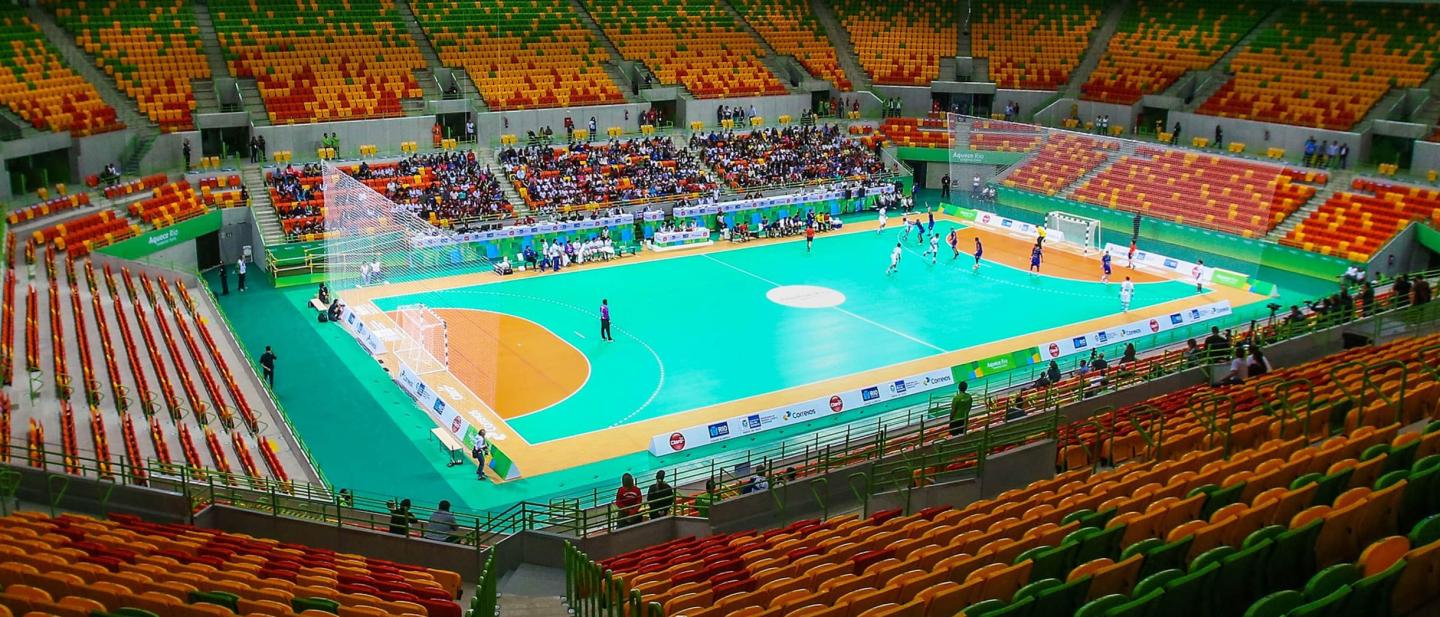Handball’s Rio 2016 legacy, eight years on
15 Feb. 2024

In just over 150 days, the Paris 2024 Olympic Games get underway in France with handball set to take centre stage as both host nation teams look to defend their Olympic titles, won at Tokyo 2020.
But the influence of handball at the Rio 2016 Olympic Games continues to have an impact to this day – and in the future.
Home to 24 teams, the Rio 2016 handball venue was called the ‘Arena do Futuro’ (Arena of the Future) and saw Denmark’s men and Russia’s women win handball gold in the 12,000-capacity arena eight years ago.
And with handball the second most popular and attended sport at Rio 2016, just behind football, the venue provided numerous special memories and emotions for those in attendance.
The arena – which also hosted goalball for the Paralympic Games – was a trailblazer, constructed using a concept known as ‘nomadic architecture’, which saw plans for the building to be repurposed into four schools once the global sporting and cultural event had concluded.
And those plans are now reality with two of the schools unveiled this week in low social development neighbourhoods in the city’s West zone, the same zone that will host the remaining two schools, which are due to open next month.
“Finally, we will deliver to the population of Rio the legacy of the Olympic Games Rio 2016 from the perspective of sports venues,” said Rio Mayor Eduardo Paes this week at the unveiling.
All four schools will adopt a new model of STEAM (Science, Technology, Engineering, the Arts and Mathematics) education schools introduced by the Rio city government.
“I was involved right from the very beginning of the construction of the Arena do Futuro and it’s incredible to see one of the Rio 2016 legacy plans being realised,” said Daniela Coelho, Rio 2016 Handball Sport Manager, to ihf.info.
“It completes the circle: the transformation of the arena into four schools providing an educational space for so many young people and a perfect solution for the use of some of the infrastructure used at Rio 2016.”
A variety of sites used across Brazil
Construction work began on the 1.18 million square metre Rio 2016 Olympic Park in July 2012 before it opened for the Games in August 2016. After hosting 14 Olympic and nine Paralympic disciplines, it closed in September 2016 to be transformed for public use, reopening in January 2017.
In addition to the Arena do Futuro, other Rio 2016 Olympic Park sites are in constant use by the Brazilian public both at the park and further afield.
After hosting taekwondo and fencing, and Paralympic judo, Carioca Arena 3 was converted into a special sports education institution, ready for the start of the 2024 school year. It is the largest school in Rio’s municipal education network, spread across 18,000 square metres, comprising of 24 classrooms and sports infrastructure for 900 students.
Carioca Arena 1, the largest of the permanent arenas in the Olympic Park and host of basketball, wheelchair rugby and wheelchair basketball, has remained on site as a multisport venue, while Carioca Arena 2, host of judo, wrestling and boccia, will be ready in 2025 to serve 1,400 young people from local communities.
The Olympic Aquatics Stadium was fully dismantled after the Games with one of its swimming pools forming part of a new 234,000-square metre public park. Its three other temporary swimming pools were disassembled and donated a few years ago for high-performance and recreational use in the Brazilian states of Amazonas, Bahia and São Paulo.
The Rio Olympic Velodrome is currently home to 20 different sports and recreational activities, as well as being host to national and international competitions. Work is currently underway to provide an exhibition centre and Rio Olympic Museum which are set to open later this year.
The Olympic Way, a pedestrian way in the Olympic Park, which provided access to the venues during the Games, has been open to the public since the Games finished and has been the venue for the Rock in Rio festival since 2017. It is now being turned into a public park with over 900 trees and 16,000 bushes planted throughout its 36,000 square metres.
“People have asked me about the legacy of Rio 2016,” added Coelho, speaking from Santiago, Chile, where she is wrapping up her work at the 2023 Pan and Parapan American Games.
“Even without the legacy use of the Arena do Futuro, Rio de Janeiro has been left with many top sport halls that we in the handball community can use.
“The Carioca 1 Arena is available for handball use, in addition to the donation of large amounts of handball sporting equipment used at the Games which was donated to the Brazilian Handball Confederation and is being used to this day by them, including at their various national tournaments, this is great.”
Photo credit: Olympics.com

